Ultrasonic Scalpel Bit, Ultrasonic Vibration Propagation Assembly And Ultrasonic Hemostasis And Cutting System
Cao; Qun ; et al.
U.S. patent application number 16/495449 was filed with the patent office on 2020-01-23 for ultrasonic scalpel bit, ultrasonic vibration propagation assembly and ultrasonic hemostasis and cutting system. This patent application is currently assigned to BEIJING SMTP TECHNOLOGY CO., LTD.. The applicant listed for this patent is BEIJING SMTP TECHNOLOGY CO., LTD.. Invention is credited to Qun Cao, Zhen Feng, Xiaoming Hu, Chunyuan Li, Songtao Zhan.
| Application Number | 20200022720 16/495449 |
| Document ID | / |
| Family ID | 66750036 |
| Filed Date | 2020-01-23 |
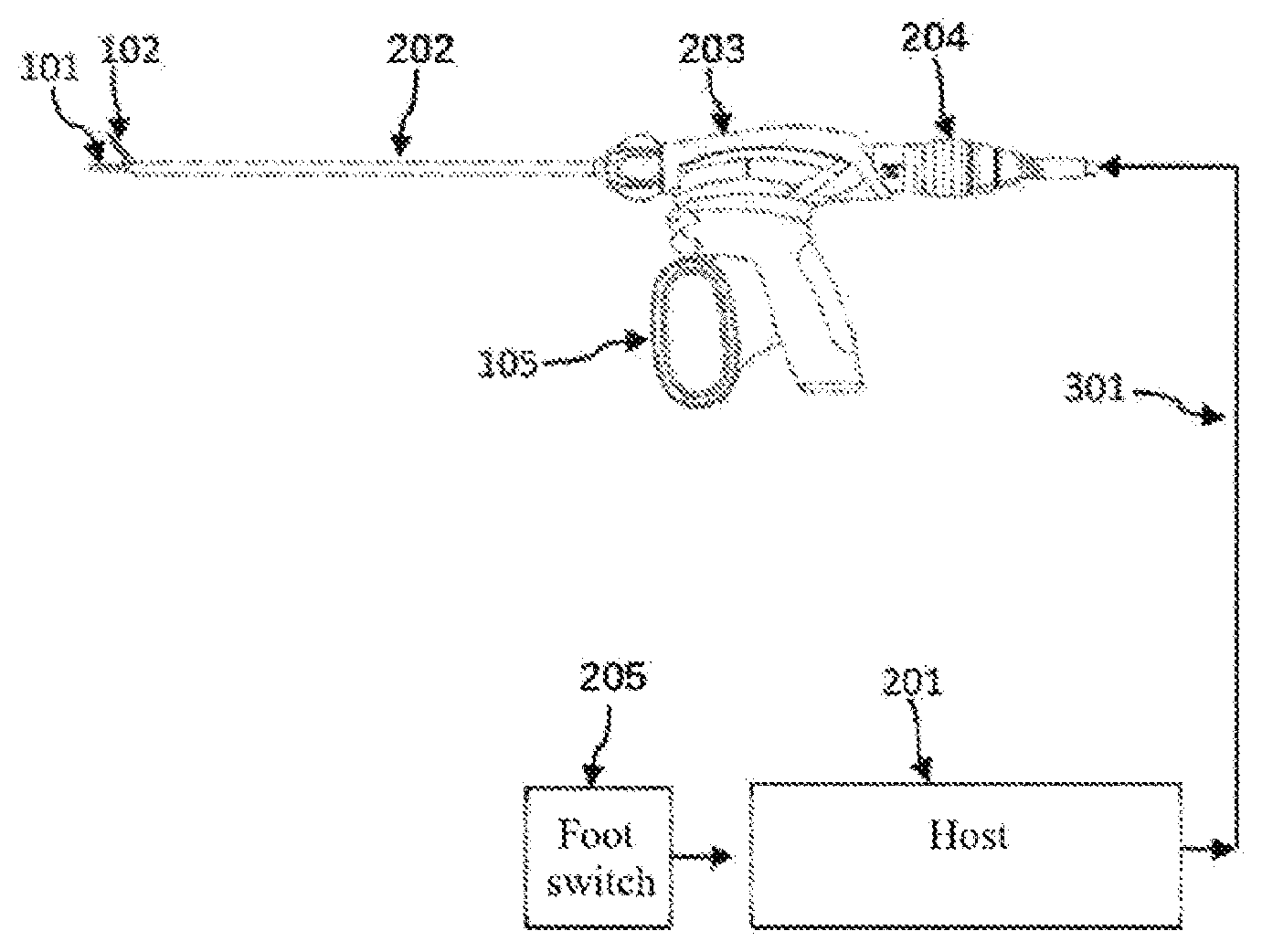
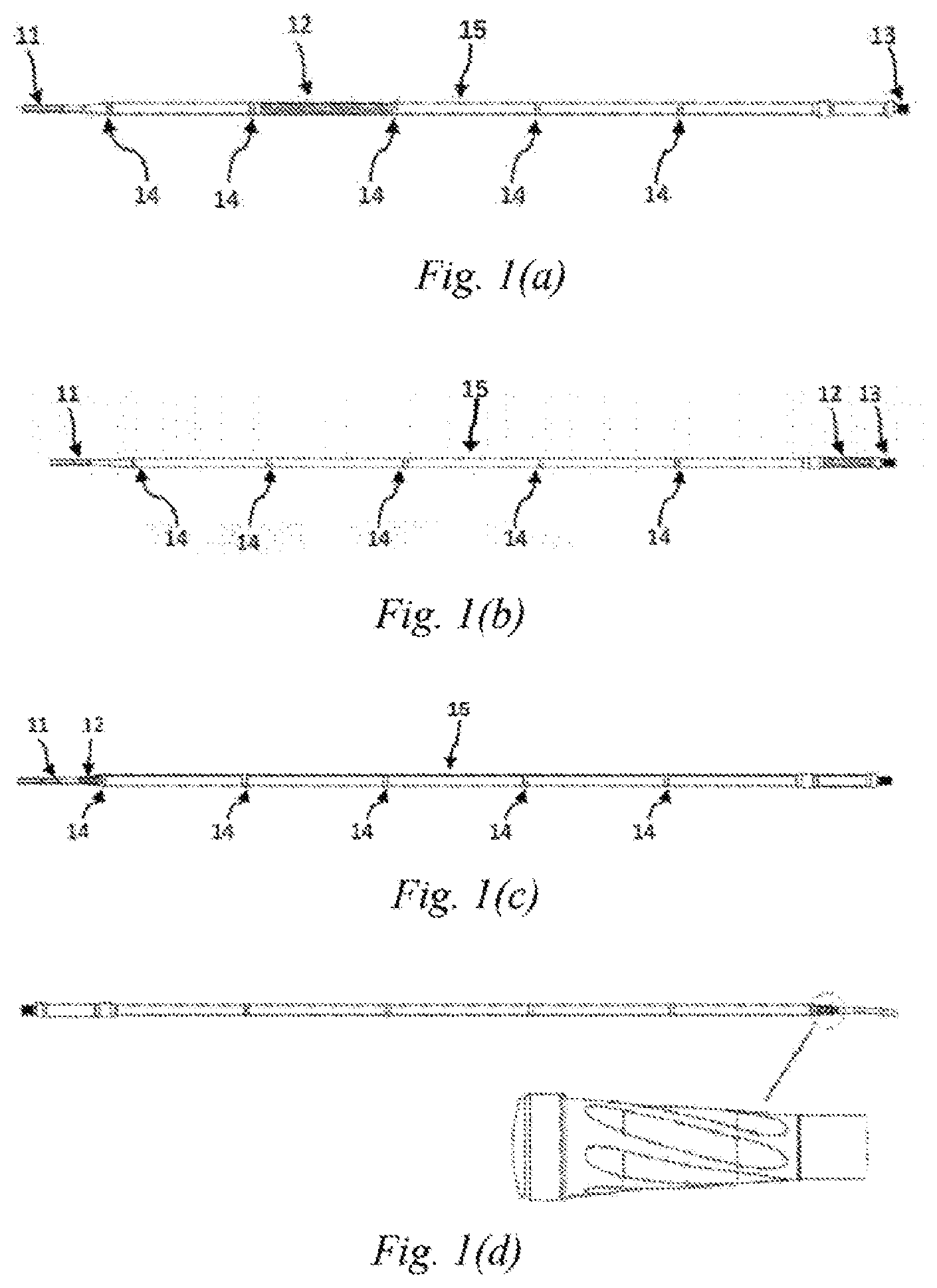
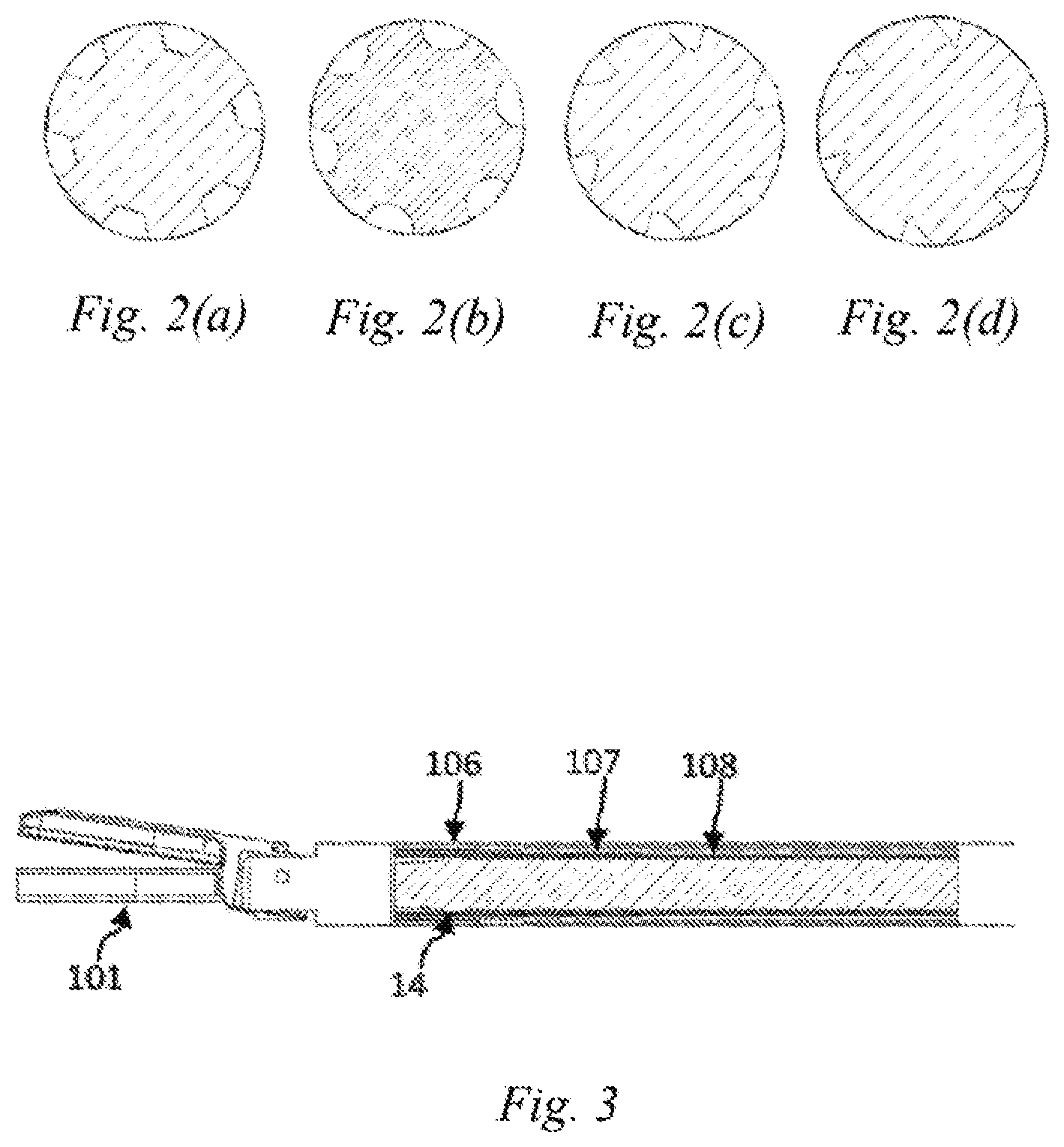
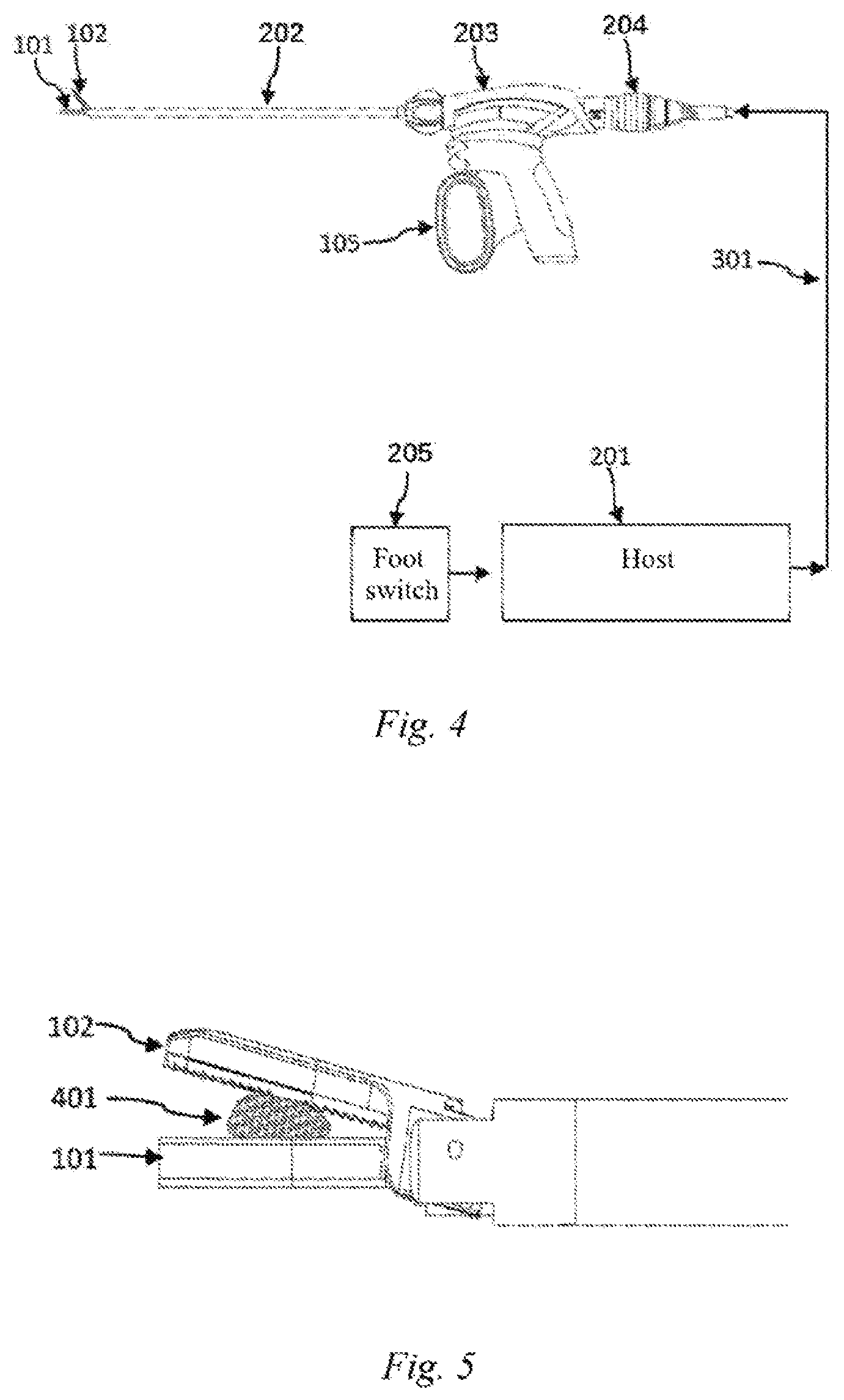
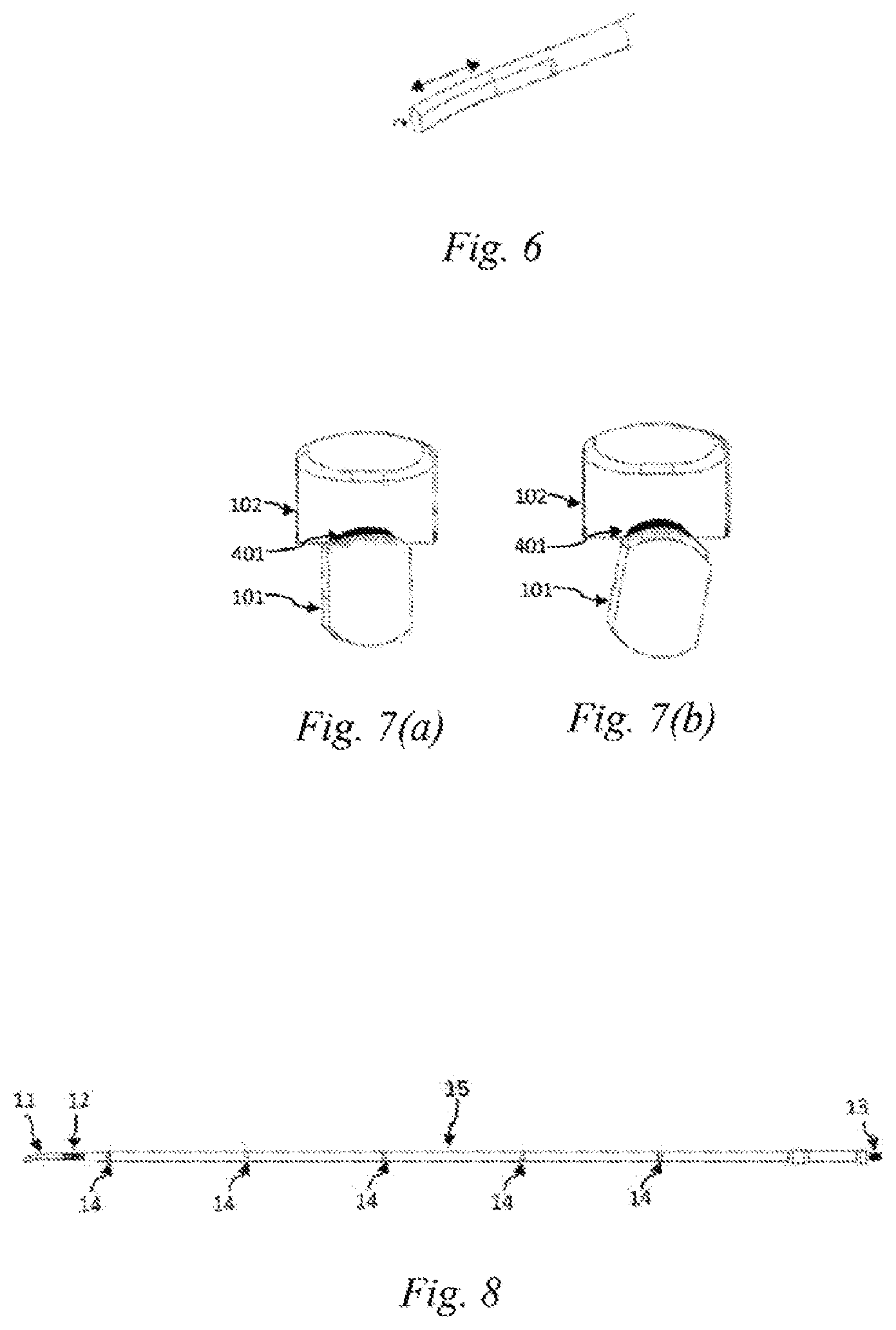
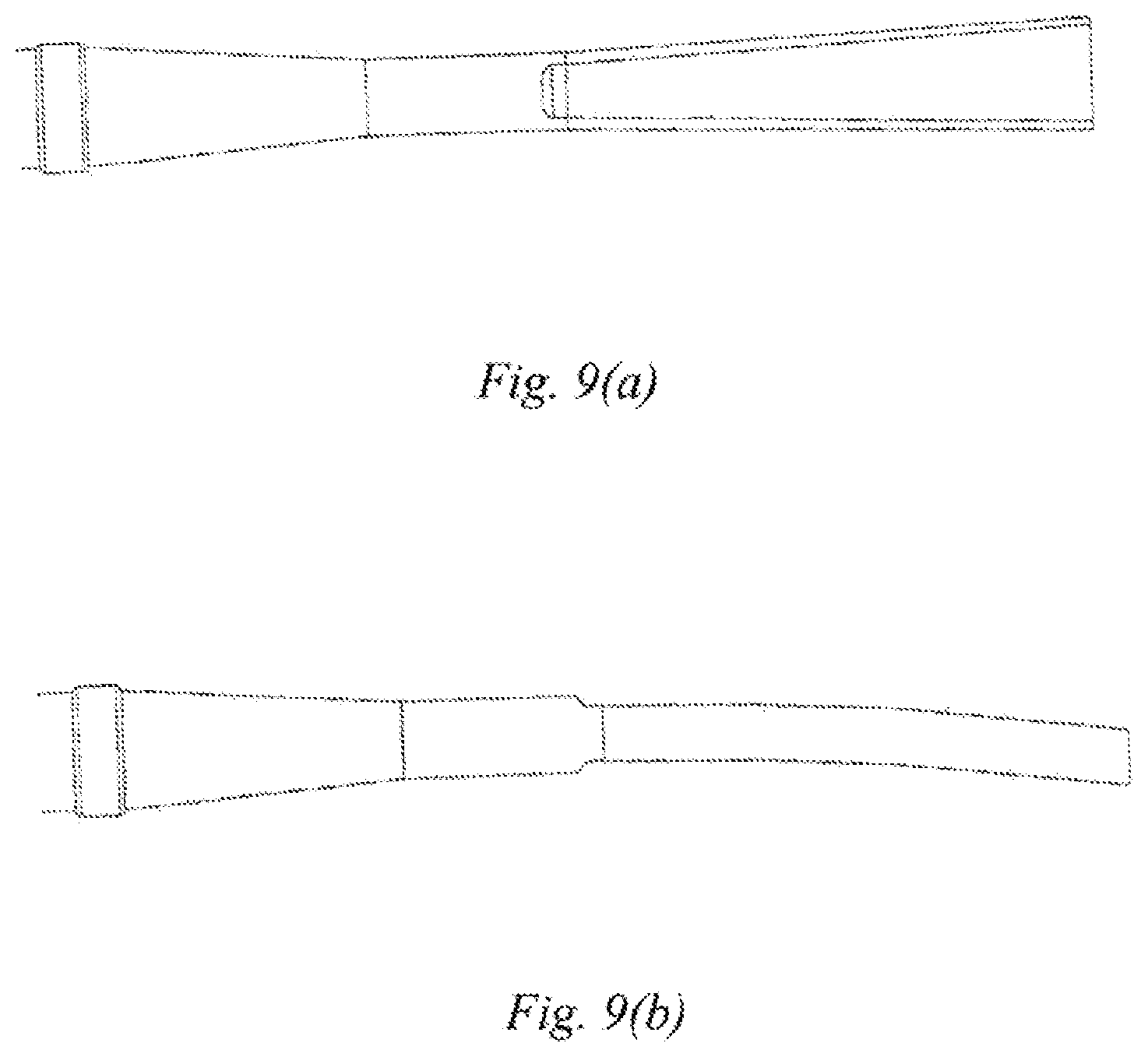
| United States Patent Application | 20200022720 |
| Kind Code | A1 |
| Cao; Qun ; et al. | January 23, 2020 |
ULTRASONIC SCALPEL BIT, ULTRASONIC VIBRATION PROPAGATION ASSEMBLY AND ULTRASONIC HEMOSTASIS AND CUTTING SYSTEM
Abstract
Disclosed is an ultrasonic hemostasis and cutting system, comprising an ultrasonic vibration propagation assembly. An ultrasonic scalpel bit (101) of the ultrasonic vibration propagation assembly comprises an ultrasonic scalpel tip (11), a connection portion (13), vibration node bosses (14) and a waveguide (15), wherein the ultrasonic scalpel tip (11) is arranged in front of the waveguide (15), the connection portion (13) is arranged behind the waveguide (15), the vibration node bosses (14) are arranged on the waveguide (15), the ultrasonic scalpel tip (11) is laterally bent at a pointed end thereof, and a vibration guide groove (12) is further provided on the ultrasonic scalpel bit (101). By designing the ultrasonic scalpel bit in a bent shape and converting a longitudinal ultrasonic vibration into a longitudinal torsional composite vibration, temperature uniformity inside a tissue being cut or coagulated can be improved, thereby improving the efficiency and safety of hemostasis and cutting.
| Inventors: | Cao; Qun; (Beijing, CN) ; Hu; Xiaoming; (Beijing, CN) ; Zhan; Songtao; (Beijing, CN) ; Feng; Zhen; (Beijing, CN) ; Li; Chunyuan; (Beijing, CN) | ||||||||||
| Applicant: |
|
||||||||||
|---|---|---|---|---|---|---|---|---|---|---|---|
| Assignee: | BEIJING SMTP TECHNOLOGY CO.,
LTD. Beijing CN |
||||||||||
| Family ID: | 66750036 | ||||||||||
| Appl. No.: | 16/495449 | ||||||||||
| Filed: | December 7, 2017 | ||||||||||
| PCT Filed: | December 7, 2017 | ||||||||||
| PCT NO: | PCT/CN2017/115037 | ||||||||||
| 371 Date: | September 19, 2019 |
| Current U.S. Class: | 1/1 |
| Current CPC Class: | A61B 18/04 20130101; A61B 2017/320094 20170801; A61B 2017/320098 20170801; A61B 17/320068 20130101; A61B 2017/320078 20170801; A61B 17/320092 20130101; A61B 17/3211 20130101 |
| International Class: | A61B 17/3211 20060101 A61B017/3211; A61B 17/32 20060101 A61B017/32; A61B 18/04 20060101 A61B018/04 |
Claims
1. An ultrasonic scalpel bit (101), comprising: an ultrasonic scalpel tip (11); a connection portion (13); vibration node bosses (14); and a waveguide (15), wherein the ultrasonic scalpel tip (11) is arranged in front of the waveguide (15), the connection portion (13) is arranged behind the waveguide (15), and the vibration node bosses (14) are arranged on the waveguide (15), wherein the ultrasonic scalpel tip (11) is laterally bent at a pointed end thereof, and wherein a vibration guide groove (12) is further provided on the ultrasonic scalpel bit (101).
2. The ultrasonic scalpel bit (101) of claim 1, wherein the vibration guide groove (12) is located on the ultrasonic scalpel tip (11) at a rear end of the ultrasonic scalpel tip (11).
3. The ultrasonic scalpel bit (101) of claim 1, wherein the vibration guide groove (12) is provided on the waveguide (15) and is located between the vibration node bosses (14).
4. The ultrasonic scalpel bit (101) of claim 1, wherein the vibration guide groove (12) is configured as a beveled groove that advances spirally along an ultrasound axis, a pitch of which is uniform or non-uniform.
5. The ultrasonic scalpel bit (101) of claim 4, wherein a ratio of the pitch of the vibration guide groove (12) to the wavelength of an ultrasonic vibration is 0.2 to 2.
6. The ultrasonic scalpel bit (101) of claim 4, wherein the beveled groove is in the shape of a trapezoid, a semi-circle, or a triangle.
7. (canceled)
8. The ultrasonic scalpel bit (101) of claim 4, wherein multiple beveled grooves are arranged on the ultrasonic scalpel bit at equal intervals.
9. The ultrasonic scalpel bit (101) of claim 1, wherein the ultrasonic scalpel tip (11) comprises a gradually-varying width in addition to being laterally bent at the pointed end thereof.
10. The ultrasonic scalpel bit (101) of claim 9, wherein the gradually-varying width is a trapezoidal gradually-varying width.
11. An ultrasonic vibration propagation assembly (202), comprising an ultrasonic scalpel bit of claim 1.
12. The ultrasonic vibration propagation assembly (202) of claim 11, further comprising: a support structure; and a clamping arm (102), wherein the clamping arm (102) is located at a front end of the support structure, and the support structure comprises an outer sleeve (106), an inner sleeve (107) and a lubrication cylinder (108), the ultrasonic scalpel bit (101) being located inside the lubrication cylinder (108).
13. The ultrasonic vibration propagation assembly of claim 12, wherein the lubrication cylinder (108) is a polytetrafluoroethylene casing.
14. An ultrasonic hemostasis and cutting system, comprising an ultrasonic vibration propagation assembly of claim 11.
15. The ultrasonic hemostasis and cutting system of claim 14, further comprising: a host (201); a handle (203); an ultrasonic transducer (204) and a foot switch (205) or a button, wherein the handle (203) is operatively connected with the foot switch (205) or the button, the ultrasonic scalpel bit (101) of the ultrasonic vibration propagation assembly is removably connected to the ultrasonic transducer (204) via a connection portion (13) at a rear end of the ultrasonic scalpel bit, and the host (201) is electrically connected to the ultrasonic transducer (204) via a cable.
Description
TECHNICAL FIELD
[0001] The present disclosure relates to the technical field of medical instruments, and in particular to an ultrasonic scalpel bit, an ultrasonic vibration propagation assembly, and an ultrasonic hemostasis and cutting system.
BACKGROUND
[0002] Compared with ordinary scalpels and other energy surgical instruments, ultrasonic hemostasis and cutting systems have advantages such as easy operation, small surgical trauma area, no smoke, less amount of bleeding, high precision of surgery, and quick postoperative recovery, and have been widely used in surgery.
[0003] During coagulation or cutting, microscopic temperature uniformity of the ultrasonic hemostasis and cutting systems mainly depends on the temperature diffusion rate inside tissues and the uniformity of frictional heat generation caused by ultrasonic vibrations. Ultrasonic scalpel tips of existing ultrasonic hemostasis and cutting systems are straight cutters, and the ultrasonic scalpel bits only produce longitudinal vibrations. When the ultrasonic scalpel tip is in a balanced position, a gap between the ultrasonic scalpel tip and a clamping arm is at the minimum, and the clamping pressure of the ultrasonic scalpel tip and the clamping arm on a biological tissue is maximized, as shown in FIG. 7(a). According to the principle of longitudinal ultrasonic vibration, the further away from the ultrasonic scalpel tip, the smaller the longitudinal amplitude. When the ultrasonic scalpel is used to cut the biological tissue, the clamping pressure of the scalpel tip and the end of the scalpel on the tissue will also vary with the thickness of the clamped tissue, the change in the position where the tissue is clamped by the ultrasonic scalpel bit, and the change in the elasticity of the tissue after heating and denaturation. As a result, the heat generated by the ultrasonic vibration differs a lot, and the temperature inside the tissue being cut or coagulated is not uniform, so that there is a relatively large difference in the coagulation and cutting effects of the ultrasonic scalpel bit at different positions. For example, when hemostasis or cutting is performed on a biological tissue such as a large-diameter blood vessel, there is a condition in which the hemostasis or cutting has been done at the position being cut by the scalpel tip, but the hemostasis has not yet done at the remaining positions. In this case, if the cutting operation is still continued, the tissue at the position being cut by the scalpel tip may be overheated to cause adverse effects such as high-temperature carbonization, which may endanger the safety of a patient.
SUMMARY OF THE DISCLOSURE
[0004] The present disclosure provides an ultrasonic scalpel bit, an ultrasonic vibration propagation assembly, and an ultrasonic hemostasis and cutting system, in order to solve the problem of poor cutting and hemostasis effects on biological tissues such as large blood vessels in the prior art.
[0005] In a first aspect, the present disclosure provides an ultrasonic scalpel bit, comprising an ultrasonic scalpel tip, a connection portion, vibration node bosses and a waveguide, wherein the ultrasonic scalpel tip is arranged in front of the waveguide, the connection portion is arranged behind the waveguide, the vibration node bosses are arranged on the waveguide, the ultrasonic scalpel tip is laterally bent at a pointed end thereof, and a vibration guide groove is further provided on the ultrasonic scalpel bit.
[0006] Further, the vibration guide groove is located on the ultrasonic scalpel tip, at a rear end of the ultrasonic scalpel tip.
[0007] Further, the vibration guide groove is provided on the waveguide and is located between two vibration node bosses.
[0008] Further, the vibration guide groove is configured as beveled groove, which advances spirally along an ultrasound axis, and pitch of which is uniform or non-uniform.
[0009] Further, the ratio of the pitch of the vibration guide groove to the wavelength of an ultrasonic vibration is 0.2.about.2.
[0010] Further, the beveled groove is in the shape of a trapezoid, a semi-circle or a triangle.
[0011] Further, at least one said beveled groove is provided.
[0012] Further, the beveled grooves are arranged on the ultrasonic scalpel bit at equal intervals.
[0013] Further, the ultrasonic scalpel tip has a gradually-varying width in addition to being laterally bent at the pointed end thereof.
[0014] Further, the gradually-varying width is a trapezoidal gradually-varying width.
[0015] In a second aspect, the present disclosure further provides an ultrasonic vibration propagation assembly, comprising an ultrasonic scalpel bit as described above.
[0016] Further, the ultrasonic vibration propagation assembly further comprises a support structure and a clamping arm, wherein the clamping arm is located at a front end of the support structure, and wherein the support structure comprises an outer sleeve, an inner sleeve and a lubrication cylinder, the ultrasonic scalpel bit being located inside the lubrication cylinder.
[0017] Further, the lubrication cylinder is a polytetrafluoroethylene casing.
[0018] In a third aspect, the present disclosure further provides an ultrasonic hemostasis and cutting system, comprising an ultrasonic vibration propagation assembly as described above.
[0019] Further, the ultrasonic hemostasis and cutting system further comprises a host, a handle, an ultrasonic transducer and a foot switch or a button, wherein the handle comprises a clamping switch, the ultrasonic scalpel bit of the ultrasonic vibration propagation assembly is removably connected to the ultrasonic transducer via a connection portion at a rear end of the ultrasonic scalpel bit, and the host is electrically connected to the ultrasonic transducer via a cable.
[0020] In the present disclosure, by designing the bit of the ultrasonic hemostasis and cutting system in a bent shape and converting a longitudinal ultrasonic vibration into a longitudinal-torsional composite vibration, on the one hand, the dependence of the temperature uniformity inside the tissue on the vibration direction is reduced, and the effective length of the vibration friction is increased: and on the other hand, when the ultrasonic scalpel bit in the bent shape is subjected to a torsional vibration, the clamping pressures of the clamping arm are different at positions with different distances from the scalpel tip. The clamping pressure is greatly reduced in an area near the scalpel tip, whereas the pressure is reduced less in an area remote from the scalpel tip. Therefore, the temperature uniformity inside the tissue being cut or coagulated is improved, thereby improving the efficiency and safety of cutting and hemostasis.
[0021] In the present disclosure, the frictional heat generation effect between the vibration guide groove and the lubrication cylinder is further reduced by providing the vibration guide groove at the rear end of the ultrasonic scalpel tip. In addition, the assembly process is simplified by designing a polytetrafluoroethylene casing in the support structure of the ultrasonic vibration propagation assembly, thereby reducing assembly time.
[0022] In the present disclosure, the mass distribution law of the ultrasonic scalpel tip along a vibration axis is changed by making the ultrasonic scalpel bit have a gradually-varying width, such that the amplitude and pressure distribution characteristics of the ultrasonic scalpel tip along the vibration axis are improved, further improving the temperature uniformity of the ultrasonic scalpel tip during coagulation or cutting of the biological tissue, thereby improving the hemostasis effect.
BRIEF DESCRIPTION OF THE DRAWINGS
[0023] FIGS. 1(a)-1(d) are schematic structural views of an ultrasonic scalpel bit of Embodiment 1 of the present disclosure;
[0024] FIGS. 2(a)-2(d) are schematic views of the shape of an ultrasonic vibration guide groove of Embodiment 1 of the present disclosure;
[0025] FIG. 3 is a schematic structural view of an ultrasonic vibration propagation assembly of Embodiment 1 of the present disclosure;
[0026] FIG. 4 is a schematic view of an ultrasonic hemostasis and cutting system of Embodiment 1 of the present disclosure;
[0027] FIG. 5 is a schematic view of a biological tissue clamped by the ultrasonic hemostasis and cutting system of Embodiment 1 of the present disclosure;
[0028] FIG. 6 is a schematic view of a composite vibration formed from longitudinal and torsional vibrations of the ultrasonic scalpel bit of Embodiment 1 of the present disclosure;
[0029] FIG. 7 (a) is a schematic view of a gap between a clamping arm and an existing ultrasonic scalpel tip;
[0030] FIG. 7 (b) is a schematic view of a gap between a clamping arm and an ultrasonic scalpel tip of Embodiment 1 of the present disclosure;
[0031] FIG. 8 is a schematic structural view of an ultrasonic scalpel bit of Embodiment 2 of the present disclosure;
[0032] FIG. 9(a) is a top view of an ultrasonic scalpel tip having a trapezoidal gradually-varying width of Embodiment 3 of the present disclosure; and
[0033] FIG. 9(b) is a side view of the ultrasonic scalpel tip having the trapezoidal gradually-varying width of Embodiment 3 of the present disclosure.
DETAILED DESCRIPTION OF EMBODIMENTS
[0034] In the following embodiments, the detailed description and the drawings illustrate in conjunction how the disclosed embodiments are implemented. It is to be understood that other embodiments are feasible, and the embodiments may be modified structurally or logically without departing from the scope disclosed in the present disclosure.
Embodiment 1
[0035] This embodiment discloses an ultrasonic scalpel bit 101, the structure of which is as shown in FIGS. 1(a), 1(b), 1(c), 6 and 8, comprising an ultrasonic scalpel tip 11, a waveguide 15, a connection portion 13 and vibration node bosses 14, wherein the ultrasonic scalpel tip 11 is arranged in front of the waveguide 15, the connection portion 13 is arranged behind the waveguide 15, the vibration node bosses 14 are arranged on the waveguide 15, the ultrasonic scalpel tip 11 is laterally bent at a pointed end thereof, and a vibration guide groove 12 is provided on the waveguide 15. Among the above components, the ultrasonic scalpel tip 11 is used to perform cutting and hemostasis operations on a biological tissue 401; the vibration guide groove 12 is used to convert a longitudinal vibration of an ultrasonic transducer into a longitudinal-torsional composite vibration; the connection portion 13 is used to connect the ultrasonic scalpel bit to the ultrasonic transducer to achieve continuous propagation of ultrasonic vibration, which is convenient for a surgeon to perform cleaning and disinfection operations, and the connection portion 13 may be connection threads; the vibration node bosses 14 are used to support the ultrasonic scalpel bit 101 and reduce the friction between the ultrasonic scalpel bit 101 and the support structure during vibration, and the number of vibration node bosses is not limited; and the waveguide 15 is used to propagate the ultrasonic vibration. The vibration guide groove 12 may be provided between two vibration node bosses 14 of the waveguide 15, or may be provided at another location on the waveguide 15.
[0036] Further, as shown in FIG. 1(d), the ultrasonic vibration guide groove 12 is configured as beveled groove which advances spirally along an ultrasound axis, and the shape of the beveled groove may be a trapezoid, a semi-circle or a triangle, as shown in FIGS. 2(a)-(d). Pitch may be uniform or non-uniform. Preferably, the ratio of the pitch of the guide groove to the wavelength of the ultrasonic vibration is 0.2-2. The number of the guide grooves is at least one. Preferably, the guide grooves are arranged at equal intervals in a circumferential direction of the ultrasonic scalpel bit.
[0037] Further, as shown in FIGS. 3 and 5, an ultrasonic vibration propagation assembly is further disclosed in this embodiment, which comprises an ultrasonic scalpel bit 101, a support structure and a clamping arm 102. The clamping arm 102 is located at a front end of the support structure. The support structure comprises an outer sleeve 106, an inner sleeve 107, and a lubrication cylinder 108. A rear end of the ultrasonic scalpel bit 101 is located inside the lubrication cylinder 108. The inner sleeve 107 and the outer sleeve 106 are sheathed outside the lubrication cylinder 108. The vibration node bosses 14 can form a support for the ultrasonic scalpel bit together with the lubrication cylinder 108, the inner sleeve 107 and the outer sleeve 106, and can also reduce the heat generation caused by the friction between the ultrasonic scalpel bit and the support member during vibration. In addition, the lubrication cylinder 108 may also be made of a low-friction-coefficient material such as a polytetrafluoroethylene casing, to further reduce the friction. At the same time, the use of a polytetrafluoroethylene casing can simplify the assembly process and reduce the time taken for assembly compared to the prior art in which each vibration node boss 14 is provided with a collar.
[0038] In addition, as shown in FIG. 4, this embodiment further comprises an ultrasonic hemostasis and cutting system, comprising a host 201, an ultrasonic vibration propagation assembly 202, a handle 203, an ultrasonic transducer 204, and a foot switch or a button 205, wherein the handle 203 comprises a clamping switch 105, the host 201 is connected to the ultrasonic transducer 204 via a cable 301, and the ultrasonic scalpel bit 101 of the ultrasonic vibration propagation assembly 202 is removably connected to the ultrasonic transducer 204 via a connection portion 13 at a rear end of the ultrasonic scalpel bit. The ultrasonic transducer 204 is used to convert a high-voltage electrical signal into an ultrasound vibration to drive the ultrasonic scalpel bit to operate. The host 201 is used to detect the access of the ultrasonic handle, control and adjust an ultrasonic driving signal so that the ultrasonic system can operate at the optimal resonance frequency, and also identify and detect the vibration state of the handle, such as identifying current, voltage and phase parameters of the ultrasonic driving signal, and detecting whether the driving signal is over-current, open-circuit or short-circuit. The host 201 can enable a user to perform the starting, stopping and other operations by means of the foot switch or the button 205, to control the output and stop of ultrasound, and can also achieve the functions such as the setting of the output power of the ultrasonic hemostatic scalpel, fault diagnosis and warning by means of a user's operation interface. The surgeon manipulates the clamping switch 105, driving the clamping arm 102 of the ultrasonic vibration propagation assembly 202 to rotate via the outer sleeve 106 and the inner sleeve 107. The clamping arm 102 and the ultrasonic scalpel tip 11 together perform the clamping operation on the biological tissue 401, as shown in FIG. 5.
[0039] In this embodiment, by providing the vibration guide groove 12 on the ultrasonic scalpel bit 101, the longitudinal vibration of the ultrasonic transducer can be converted into the longitudinal-torsional composite vibration, so that the ultrasonic scalpel bit is longitudinally vibrated and twisted at the same time, to form a composite vibration, as shown in FIG. 6. At the same time, since the ultrasonic scalpel tip 11 is laterally bent at the pointed end portion thereof, the size of the gap between the ultrasonic scalpel tip 11 and the clamping arm 102 varies periodically with the change of the vibration and torsion when the bent ultrasonic scalpel tip in this embodiment is used to cooperate with the longitudinal-torsional composite vibration. When the torsional vibration reaches the maximum displacement, the gap between the ultrasonic scalpel tip 11 and the clamping arm 102 is the largest, as shown in FIG. 7(b), at which time the clamping pressure of the ultrasonic scalpel tip 11 and the clamping arm 102 on the biological tissue is minimized, and the difference in the clamping strength between the scalpel tip portion and the other portions of the bit is reduced compared to the prior art ultrasonic scalpel which uses a straight bit and does not generate a torsional vibration. As a result, the difference in the amount of the generated heat is reduced, and the temperature inside the tissue being cut or coagulated is more uniform, which is conducive to closing the biological tissue such as a large blood vessel.
Embodiment 2
[0040] As shown in FIG. 8, different from Embodiment 1 in which the vibration guide groove is provided on the waveguide 15, in this embodiment, the ultrasound guide groove 12 of the ultrasonic scalpel bit 101 is provided on the ultrasonic scalpel tip 11, and is located at a rear end of the ultrasonic scalpel tip 11. The frictional heat generation effect between the vibration guide groove 12 and the lubrication cylinder 108 can be further reduced by means of the above arrangement.
Embodiment 3
[0041] This embodiment further defines the shape of the ultrasonic scalpel tip 11 of the ultrasonic scalpel bit 101 on the basis of Embodiment 1 or 2. That is, the ultrasonic scalpel tip 11 comprises a gradually-varying width in addition to being laterally bent at the pointed end thereof. For example, the gradually-varying width may be a trapezoidal gradually-varying width, a top view of which is as shown in FIG. 9(a) in which the front end of the ultrasonic scalpel tip 11 has a width larger than that of the rear end thereof, and a side view of which is as shown in FIG. 9(b). With the above design, the mass distribution law of the ultrasonic scalpel tip 11 along a vibration axis can be changed, such that the amplitude and pressure distribution characteristics of the ultrasonic scalpel tip 11 along the vibration axis are improved, further improving the temperature uniformity of the ultrasonic scalpel tip 11 during coagulation or cutting of the biological tissue 401, thereby improving the hemostasis effect.
[0042] Although various embodiments have been described in detail above, those skilled in the art will appreciate that various alternative and/or equivalent embodiments may be used to substitute for the specific disclosure of the embodiments mentioned above without departing from the disclosure of the present disclosure. This application is intended to cover any modification and variations of the various embodiments discussed.
* * * * *
D00000

D00001

D00002

D00003

D00004

D00005

XML
uspto.report is an independent third-party trademark research tool that is not affiliated, endorsed, or sponsored by the United States Patent and Trademark Office (USPTO) or any other governmental organization. The information provided by uspto.report is based on publicly available data at the time of writing and is intended for informational purposes only.
While we strive to provide accurate and up-to-date information, we do not guarantee the accuracy, completeness, reliability, or suitability of the information displayed on this site. The use of this site is at your own risk. Any reliance you place on such information is therefore strictly at your own risk.
All official trademark data, including owner information, should be verified by visiting the official USPTO website at www.uspto.gov. This site is not intended to replace professional legal advice and should not be used as a substitute for consulting with a legal professional who is knowledgeable about trademark law.